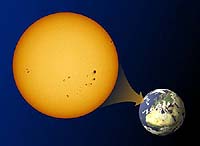| . |  |
. |
 Debating The Solar Impact On Global Warming
Debating The Solar Impact On Global WarmingWashington - March 1, 2000 - Discoveries about how the Sun may affect the Earth's climate will be discussed on the Spanish island of Tenerife, 25-30 September 2000. The leading hypothesis in climate science is that most of the warming during the 20th Century was due to manmade gases, enhancing the natural greenhouse effect that reduces heat loss into space. Behind the scenes, and especially among space scientists, there is renewed attention to natural changes in climate due to the Sun. Experts will present their findings and opinions at the conference on "The Solar Cycle and Terrestrial Climate", to be hosted in Santa Cruz de Tenerife by the Instituto de Astrof=EDsica de Canarias. The conference is co-sponsored by the European Union. Three scientists from the European Space Agency are helping to organize the scientific programme, and ESA will publish the proceedings at the end of this year. "We look forward to very lively discussions," says Manuel V=E1zquez, the Spanish astrophysicist who is the chief organizer of the conference. "We shall hear prominent experts from both a solar and a greenhouse background. But we also welcome students to Tenerife, and industrialists and environmentalists who are interested in the climate issue." A link between sunspots and climate has been a popular idea for 200 years, but ten years ago measurements by spacecraft cast doubt on it. They showed that the Sun is brighter when there are many sunspots, at the climax of each sunspot cycle of roughly 11 years, but the variations seemed too small to have a major effect on climate. These results encouraged the Intergovernmental Panel on Climate Change (IPPC) in its preference for the greenhouse hypothesis. The long-time leader of the IPCC's scientific work, Sir John Houghton, will be among the speakers at the Tenerife conference. During the past ten years astronomers and solar-terrestrial physicists have reappraised the role of the Sun. Some American scientists, who will also take part in the meeting, have argued that previous changes in the Sun's brightness were greater than those seen during the short period of satellite measurements. In Europe, there has been more emphasis on other ways in which the Sun may affect the climate, either by invisible X-rays and ultraviolet radiation, which peak when there are many sunspots, or by the solar wind, which blows non-stop from the Sun and became more vigorous during the 20th Century. For example, with the aid of results from the ESA-NASA solar spacecraft Ulysses, Mike Lockwood of the Rutherford Appleton Laboratory (UK) recently deduced that the magnetic field carried by the solar wind has doubled in strength since 1900. And the climatic record from weather satellites, showing changes in the Earth's cloud cover, suggests that cloud formation is affected by cosmic rays arriving from the Galaxy. When the Sun is most active, there are fewer cosmic rays and fewer clouds. Henrik Svensmark of the Danish Space Research Institute will present new results on that apparent link. "ESA has made a big commitment to solar-terrestrial science, in the Ulysses, SOHO and Cluster II projects," comments Bernhard Fleck, who is ESA's project scientist for SOHO and one of the planners of the Tenerife conference. "When we have established what effect the Sun has on the Earth's climate, the next task will be to understand how the Sun's behaviour in that respect may change in the decades ahead," added Fleck.
A CLIMATIC DEBATE
|
| |||||||||
| The content herein, unless otherwise known to be public domain, are Copyright 1995-2016 - Space Media Network. All websites are published in Australia and are solely subject to Australian law and governed by Fair Use principals for news reporting and research purposes. AFP, UPI and IANS news wire stories are copyright Agence France-Presse, United Press International and Indo-Asia News Service. ESA news reports are copyright European Space Agency. All NASA sourced material is public domain. Additional copyrights may apply in whole or part to other bona fide parties. Advertising does not imply endorsement, agreement or approval of any opinions, statements or information provided by Space Media Network on any Web page published or hosted by Space Media Network. Privacy Statement All images and articles appearing on Space Media Network have been edited or digitally altered in some way. Any requests to remove copyright material will be acted upon in a timely and appropriate manner. Any attempt to extort money from Space Media Network will be ignored and reported to Australian Law Enforcement Agencies as a potential case of financial fraud involving the use of a telephonic carriage device or postal service. |